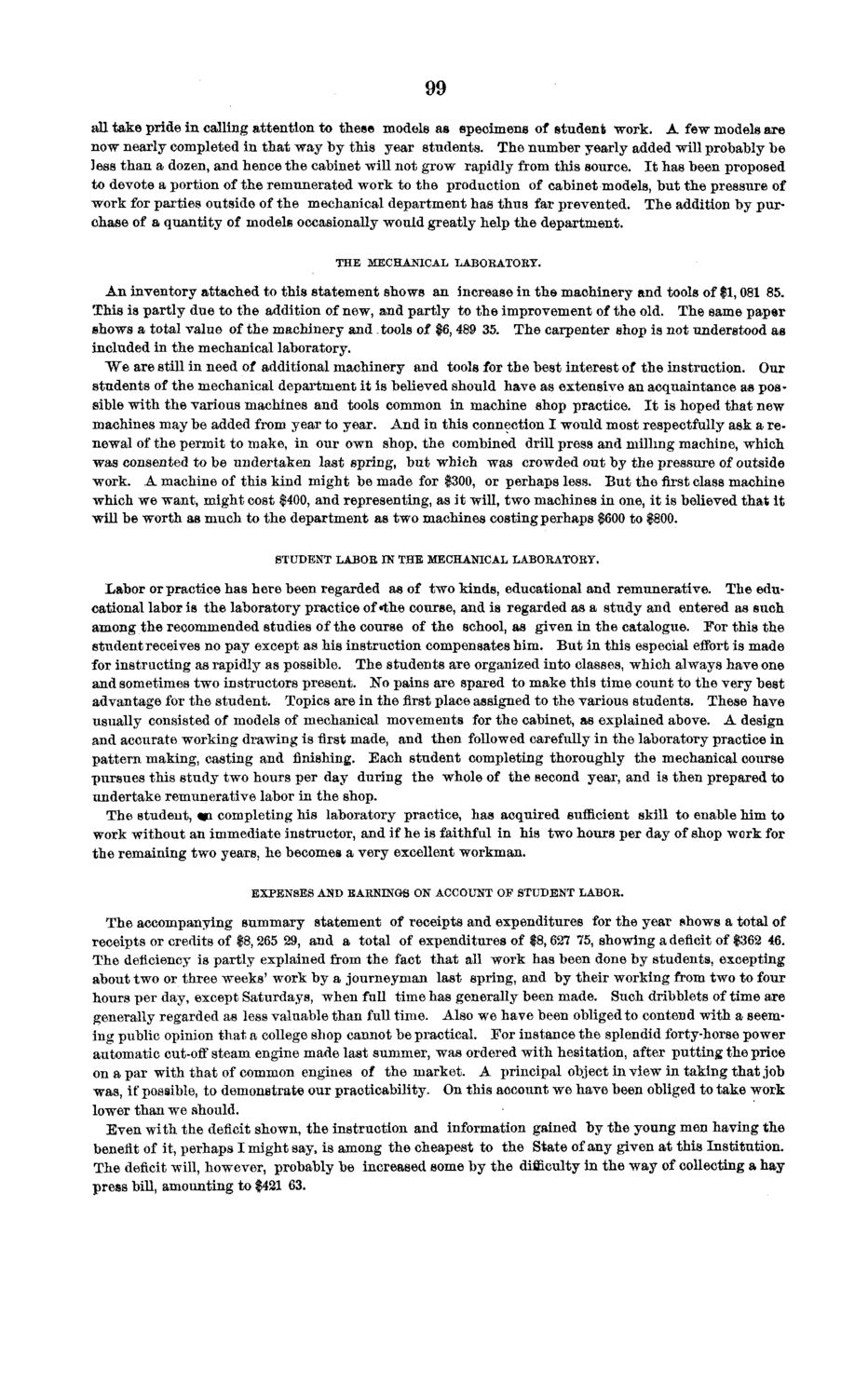| |
| |
Caption: Board of Trustees Minutes - 1873
This is a reduced-resolution page image for fast online browsing.

EXTRACTED TEXT FROM PAGE:
99 all take pride in calling attention to these models as specimens of student work. A few models are now nearly completed in that way by this year students. The number yearly added will probably be Jess than a dozen, and hence the cabinet will not grow rapidly from this source. I t has been proposed to devote a portion of the remunerated work to the production of cabinet models, but the pressure of work for parties outside of the mechanical department has thus far prevented. The addition by purchase of a quantity of models occasionally would greatly help the department. THE MECHANICAL LABORATORY. An inventory attached to this statement shows an increase in the maohinery and tools of $1,081 85. This is partly due to the addition of new, and partly to the improvement of the old. The same paper shows a total value of the machinery and tools of $6, 489 35. The carpenter shop is not understood as included in the mechanical laboratory. We are still in need of additional machinery and tools for the best interest of the instruction. Our students of the mechanical department it is believed should have as extensive an acquaintance as possible with the various machines and tools common in machine shop practice. I t is hoped that new machines may be added from year to year. And in this connection I would most respectfully ask a renewal of the permit to make, in our own shop, the combined drill press and milling machine, which was consented to be undertaken last spring, but which was crowded out by the pressure of outside work. A machine of this kind might be made for $300, or perhaps less. But the first class machine which we want, might cost $400, and representing, as it will, two machines in one, it is believed that it will be worth as much to the department as two machines costing perhaps $600 to $800. STUDENT LABOE IN THE MECHANICAL LABORATORY. Labor or practice has here been regarded as of two kinds, educational and remunerative. The educational labor is the laboratory practice of «the course, and is regarded as a study and entered as such among the recommended studies of the course of the school, as given in the catalogue. For this the student receives no pay except as his instruction compensates him. But in this especial effort is made for instructing as rapidly as possible. The students are organized into classes, which always have one and sometimes two instructors present. No pains are spared to make this time count to the very best advantage for the student. Topics are in the first place assigned to the various students. These have usually consisted of models of mechanical movements for the cabinet, as explained above. A design and accurate working drawing is first made, and then followed carefully in the laboratory practice in pattern making, casting and finishing. Each student completing thoroughly the mechanical course pursues this study two hours per day during the whole of the second year, and is then prepared to undertake remunerative labor in the shop. The student, «a completing his laboratory practice, has aoquired sufficient skill to enable him to work without an immediate instructor, and if he is faithful in his two hours per day of shop work for the remaining two years, he becomes a very excellent workman. EXPENSES AND EARNINGS ON ACCOUNT OF STUDENT LABOR. The accompanying summary statement of receipts and expenditures for the year shows a total of receipts or credits of $8,265 29, and a total of expenditures of $8,627 75, showing a deficit of $362 46. The deficiency is partly explained from the fact that all work has been done by students, excepting about two or three weeks' work by a journeyman last spring, and by their working from two to four hours per day, except Saturdays, when full time has generally been made. Such dribblets of time are generally regarded as less valuable than full time. Also we have been obliged to contend with a seeming public opinion that a college shop cannot be practical. For instance the splendid forty-horse power automatic cut-off steam engine made last summer, was ordered with hesitation, after putting the price on a par with that of common engines of the market. A principal object in view in taking that job was, if possible, to demonstrate our practicability. On this aocount we have been obliged to take work lower than we should. Even with the deficit shown, the instruction and information gained by the young men having the benefit of it, perhaps I might say, is among the cheapest to the State of any given at this Institution. The deficit will, however, probably be increased some by the difficulty in the way of collecting a hay press bill, amounting to $421 63.
| |